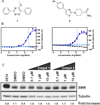Discovery, synthesis, and biological evaluation of novel SMN protein modulators
- PMID: 21819082
- PMCID: PMC3174349
- DOI: 10.1021/jm200497t
Discovery, synthesis, and biological evaluation of novel SMN protein modulators
Abstract
Spinal muscular atrophy (SMA) is an autosomal recessive disorder affecting the expression or function of survival motor neuron protein (SMN) due to the homozygous deletion or rare point mutations in the survival motor neuron gene 1 (SMN1). The human genome includes a second nearly identical gene called SMN2 that is retained in SMA. SMN2 transcripts undergo alternative splicing with reduced levels of SMN. Up-regulation of SMN2 expression, modification of its splicing, or inhibition of proteolysis of the truncated protein derived from SMN2 have been discussed as potential therapeutic strategies for SMA. In this manuscript, we detail the discovery of a series of arylpiperidines as novel modulators of SMN protein. Systematic hit-to-lead efforts significantly improved potency and efficacy of the series in the primary and orthogonal assays. Structure-property relationships including microsomal stability, cell permeability, and in vivo pharmacokinetics (PK) studies were also investigated. We anticipate that a lead candidate chosen from this series may serve as a useful probe for exploring the therapeutic benefits of SMN protein up-regulation in SMA animal models and a starting point for clinical development.
Figures









References
-
- www.fsma.org.
- Pearn J. Classification of spinal muscular atrophies. Lancet. 1980;1:919–922. - PubMed
-
- Lefebvre S, Burglen L, Reboullet S, Clermont O, Burlet P, Viollet L, Benichou B, Cruaud C, Millasseau P, Zeviani M, Le Paslier D, Frezal J, Cohen D, Weissenbach J, Munnich A, Melki J. Identification and characterization of a spinal muscular atrophy-determining gene. Cell. 1995;80:155–165. - PubMed
-
- Lefebvre S, Burlet P, Liu Q, Bertrandy S, Clermont O, Munnich A, Dreyfuss G, Melki J. Correlation between severity and SMN protein level in spinal muscular atrophy. Nat. Genet. 1997;16:265–269. - PubMed
Publication types
MeSH terms
Substances
Grants and funding
LinkOut - more resources
Full Text Sources
Other Literature Sources
Chemical Information
Medical

